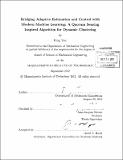| dc.contributor.advisor | Jean-Jacques Slotine. | en_US |
| dc.contributor.author | Tan, Feng, Ph. D. Massachusetts Institute of Technology | en_US |
| dc.contributor.other | Massachusetts Institute of Technology. Dept. of Mechanical Engineering. | en_US |
| dc.date.accessioned | 2013-03-28T18:13:22Z | |
| dc.date.available | 2013-03-28T18:13:22Z | |
| dc.date.copyright | 2012 | en_US |
| dc.date.issued | 2012 | en_US |
| dc.identifier.uri | http://hdl.handle.net/1721.1/78193 | |
| dc.description | Thesis (S.M.)--Massachusetts Institute of Technology, Dept. of Mechanical Engineering, 2012. | en_US |
| dc.description | Cataloged from PDF version of thesis. | en_US |
| dc.description | Includes bibliographical references (p. 89-92). | en_US |
| dc.description.abstract | Quorum sensing is a decentralized biological process, by which a community of bacterial cells with no global awareness can coordinate their functional behaviors based only on local decision and cell-medium interaction. This thesis draws inspiration from quorum sensing to study the data clustering problem, in both the time-invariant and the time-varying cases. Borrowing ideas from both adaptive estimation and control, and modern machine learning, we propose an algorithm to estimate an "influence radius" for each cell that represents a single data, which is similar to a kernel tuning process in classical machine learning. Then we utilize the knowledge of local connectivity and neighborhood to cluster data into multiple colonies simultaneously. The entire process consists of two steps: first, the algorithm spots sparsely distributed "core cells" and determines for each cell its influence radius; then, associated "influence molecules" are secreted from the core cells and diffuse into the whole environment. The density distribution in the environment eventually determines the colony associated with each cell. We integrate the two steps into a dynamic process, which gives the algorithm flexibility for problems with time-varying data, such as dynamic grouping of swarms of robots. Finally, we demonstrate the algorithm on several applications, including benchmarks dataset testing, alleles information matching, and dynamic system grouping and identication. We hope our algorithm can shed light on the idea that biological inspiration can help design computational algorithms, as it provides a natural bond bridging adaptive estimation and control with modern machine learning. | en_US |
| dc.description.statementofresponsibility | by Feng Tan. | en_US |
| dc.format.extent | 92 p. | en_US |
| dc.language.iso | eng | en_US |
| dc.publisher | Massachusetts Institute of Technology | en_US |
| dc.rights | M.I.T. theses are protected by
copyright. They may be viewed from this source for any purpose, but
reproduction or distribution in any format is prohibited without written
permission. See provided URL for inquiries about permission. | en_US |
| dc.rights.uri | http://dspace.mit.edu/handle/1721.1/7582 | en_US |
| dc.subject | Mechanical Engineering. | en_US |
| dc.title | Bridging adaptive estimation and control with modern machine learning : a quorum sensing inspired algorithm for dynamic clustering | en_US |
| dc.type | Thesis | en_US |
| dc.description.degree | S.M. | en_US |
| dc.contributor.department | Massachusetts Institute of Technology. Department of Mechanical Engineering | |
| dc.identifier.oclc | 830376813 | en_US |
